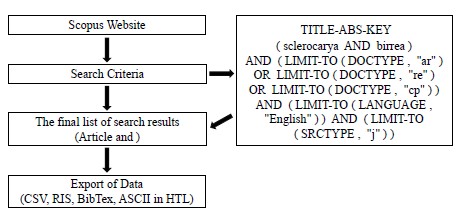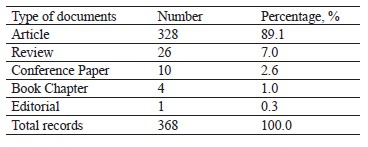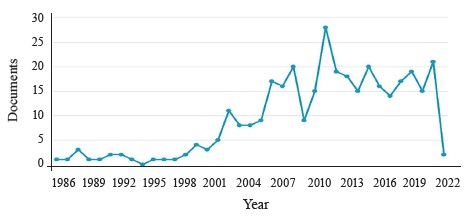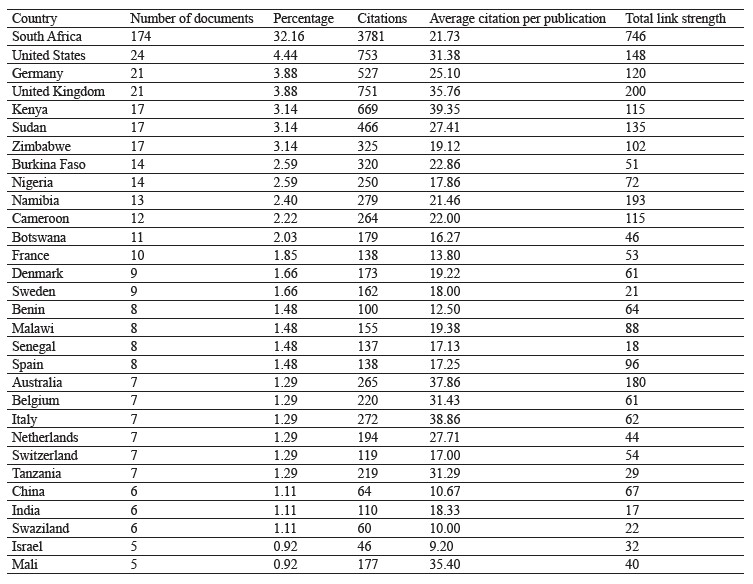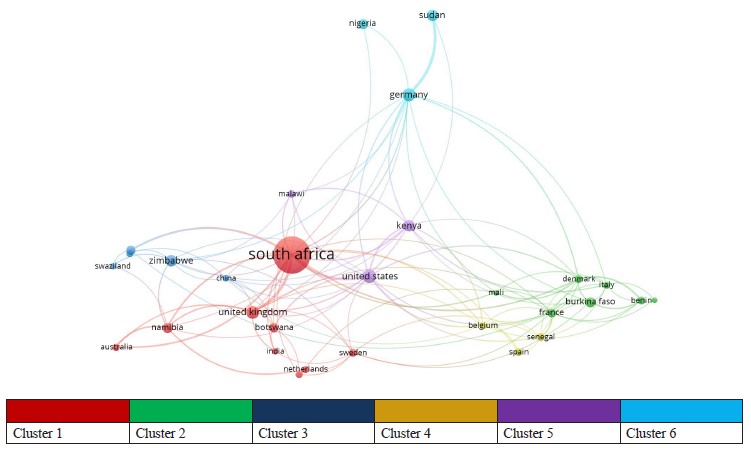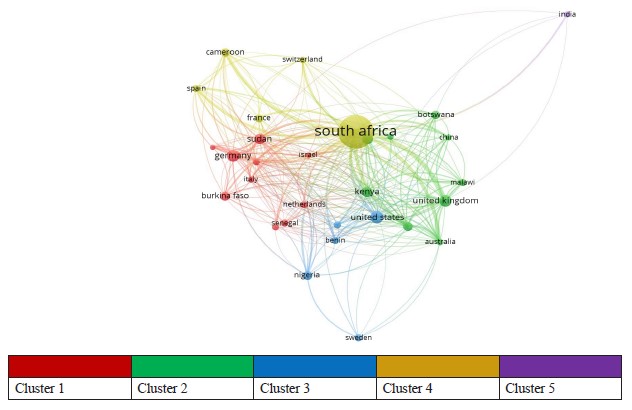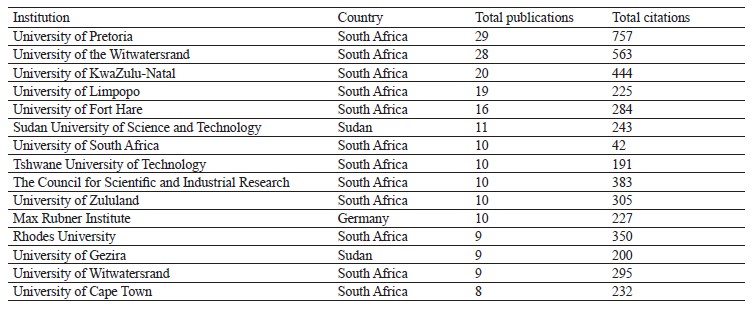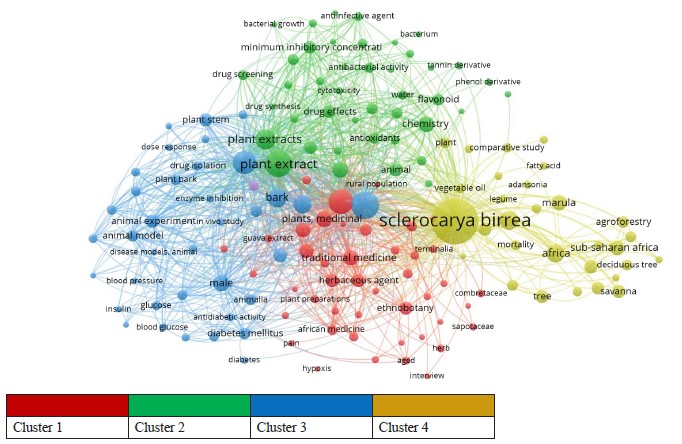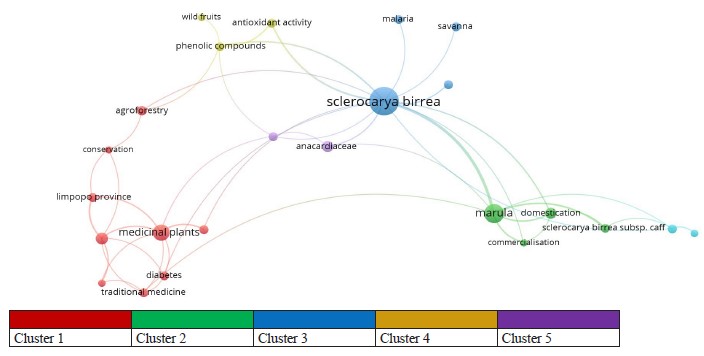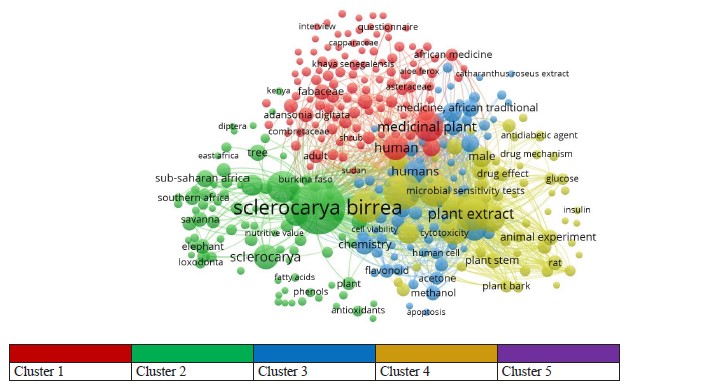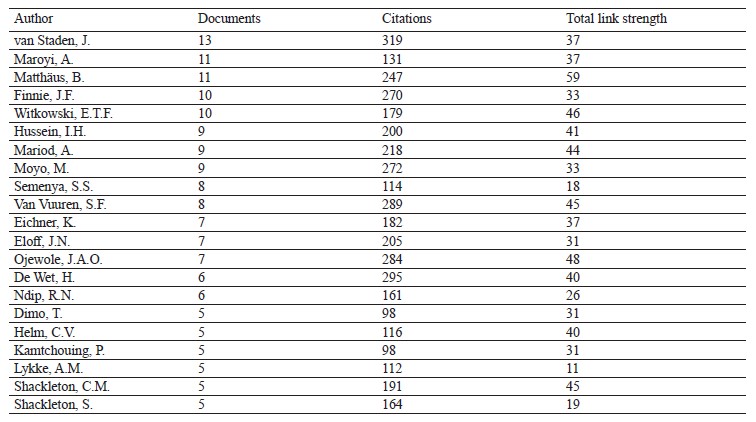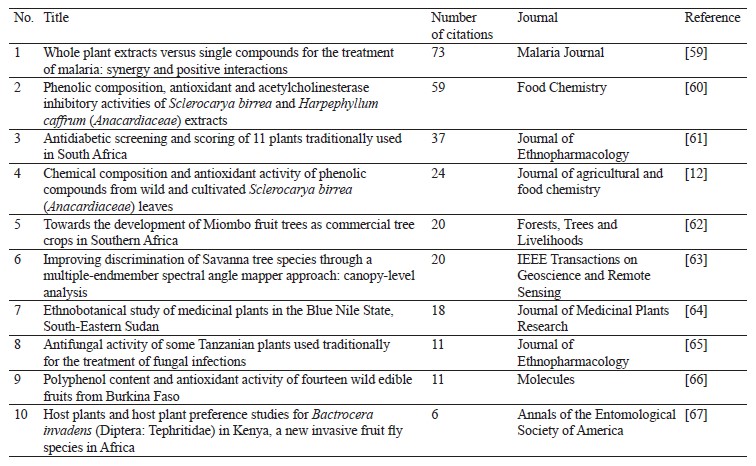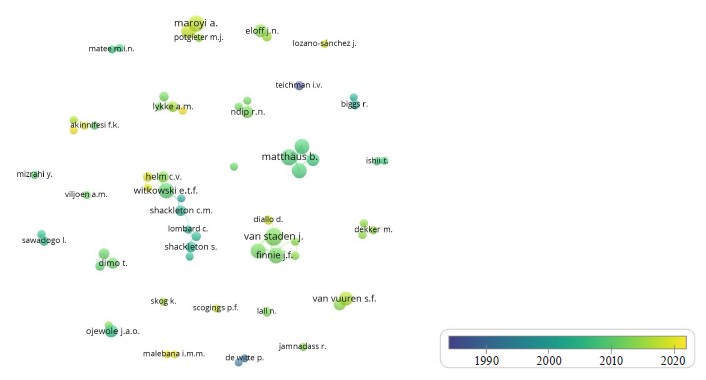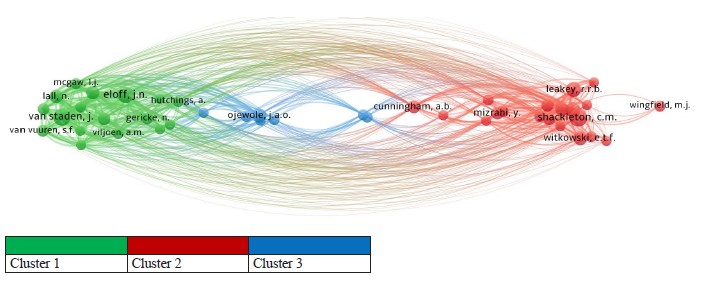Abstract
Sclerocarya birrea (A. Rich.) Hochst. is an African wild tree found in many countries across the continent. Its leaves, bark, root, and fruits are used in food, cosmetics, and traditional medicine. However, no systematic bibliometric review on S. birrea have been performed so far.This study covered publications made in 1986–2022 and investigated such bibliometric indicators as knowledge dynamics, links and structure, relevant journals, productive organizations, renowned authors, authoring patterns, national and international collaboration levels, etc. The bibliometric data on a total of 369 publications were downloaded from Scopus database and analyzed using the MS-Excel and VOSViewer software.
The Scopus publications on S. birrea showed a versatile range in the interdisciplinary areas of research, with agricultural and biological sciences predominating. The Republic of South Africa was responsible for the largest number of citations. All in all, 63 countries published research on S. birrea in the specified time period, and the share of African countries was 65.43% of the total global research. Co-authorship and international collaboration were registered for six clusters. A total of 1114 researchers and 160 institutions actively contributed to S. birrea studies, with 37 having a minimum of five publications. Mapping of knowledge structure using the keyword co-occurrence revealed the related research areas. The Journal of Ethnopharmacology took the lead in terms of average citation.
The co-citation analysis revealed some remarkable dynamics in S. birrea research. This bibliometric study provides a complete insight into S. birrea research development and publication patterns over the last 36 years.
Keywords
Bibliometric analysis, citation analysis, research-based data, Sclerocarya birrea, marula, Scopus, VOSVieweINTRODUCTION
Sclerocarya birrea (A. Rich.) Hochst. is a savannah tree from the family of Anacardiaceae. Its English name is marula. The tree requires sandy or alluvial soils; propagation is carried out with seeds or cuttings. It grows in a wide variety of soils but prefers well-drained soil. The marula survives at altitudes varying from sea level to 1800 m and at an annual rainfall range of 200– 1500 mm [1–3]. The fruits are pale yellow and plum-like, with a plain tough skin and juicy, mucilaginous flesh [4].
Glew et al. reported that S. birrea seed contained relatively large amounts of copper (24.8 mg/g dry weiht), magnesium (4210 mg/g dry weight), and zinc (62.4 mg/g dry weight) [5]. The protein content of the pit was high (36.4% of dry weight); however, the protein fraction was low in leucine, phenylalanine, lysine, and threonine. The potential benefits of marula oil are due to its high content of antioxidants and some important nutrients. In addition, marula oil also contains monounsaturated and polyunsaturated fats, which are good for health [6].
Marula oil can enhance hair health by moisturizing and fighting dryness without leaving any greasy impact, especially when used in moderate amounts [6]. Marula oil can stimulate hair in cases of dandruff or infection as it moisturizes the scalp and relieves it from dead skin cells [7]. Marula oil contains healthy fatty acids. When used in cooking, it regulates the level of cholesterol in the body, which improves the health of the heart and blood vessels, thus reducing the possibility of circulatory diseases, e.g., stroke, heart attack, and atherosclerosis [8]. Marula oil was reported to help pregnant women with skin issues [9, 10]. Marula oil contains antioxidants. As a natural antimicrobial, it can serve as a wound sterilizer that prevents infection and germs from entering the body [11].
Marula leaves and fruit pulp can treat hypertension; the leaves are used against diabetes, dysentery, snake and scorpion bites, malaria, and inflammations. The plant is also utilized as a tonic, and the fruits are often fermented as a raw material for a refreshing drink. Chemical and pharmacological studies on the bark have reported antidiarrheal activity of the decoction. It is a source of phenolic compounds, such as procyanidins and (-)epicatechin-3-galloylester. No research has been done so far on the chemical composition of S. birrea leaves, although their extract was reported to exhibit the activity with Ca2+ mobilizing systems in muscle cells [12]. Methanolic extracts from different parts of the S. birrea tree were examined for antioxidant properties. They proved to contain phenolic compounds that inhibit the oxidation of linoleic acid and the subsequent bleaching of betacarotene. The seed extract was more active, followed by extracts of roots, leaves, and bark [13].
S. birrea extract was tested against diabetes type II in an in vitro study, where it was found efficient in reducing blood pressure in diabetic rats [14]. S. birrea methanolic and aqueous extracts demonstrated antimalarial activities and were found effective against different plasmodia, the methanol extract being more active than the aqueous one [15]. In traditional African medicine, S. birrea treats hypertension, dysentery, infertility, schistosomiasis, constipation, abdominal cramps, stomachache, sore eyes, toothache, backache, body pains, and gastroenteritis. The lyophilized decoction of this plant showed great anti-diarrheic activity [16–21].
The bibliometric analysis and the literature review are tools of knowledge management, prospecting, and mapping [22]. Scientific research in medicinal plants is one of the richest fields of scientific exploration because it brings together many scientific fields, e.g., chemistry, pharmacology, veterinary sciences, botany, pharmaceutics, traditional knowledge, and computer science [23]. S. birrea is a wild tree that grows all over the African continent and is used in nutrition, cosmetics, and traditional medicine by many African nations. As a result, S. birrea is a popular research object and a source of numerous studies. However, it has acquired no bibliometric profile so far. This study fills in the gap by investigating into the patterns of scientific research and the most important researchers, universities, and countries that dealt with S. birrea in 1986–2022. Other factors involved research dynamics and development, collaboration, structure, and impact.
STUDY OBJECTS AND METHODS
Bibliometrics is a method of determining trends in publications and research in a certain field of study by analyzing data quantitatively [24, 25]. This study looks at author cooperation networks, scientific outputs and contributions, scientific impact, institutional partnerships, national shares, etc. The authors performed a complete analysis of data on involvement and collaborations among researchers worldwide, their affiliations and journals that publish articles on Sclerocarya birrea (A. Rich.) Hochst. The bibliometric study relied on the Scopus database. Such bibliometric studies are crucial for consistency and accuracy in data needed for analysis of prior works and identifying research prospects.
Selecting database and extracting bibliometric data. Scientific information can be retrieved from various databases, e.g., PubMed, Scopus, and Clarivate WOS [26]. We extracted 92, 346, and 302 publications from PubMed, Scopus, and Clarivate WOS, respectively. We chose Scopus because it is more comprehensive and contains much a greater number of research documents on the matter, compared to WOS and PubMed [27]. Also, PubMed does not contain scientific papers that are concerned with pure botanical research. Scopus is an Elsevier-produced platform that provides indexing and abstract database with research publication linkages. Scopus was founded in 2004 and now hosts over 70 million papers from a variety of disciplines [28]. It is popular among scholars and simple to use. Scopus also provides extensive data and insights on research papers across a wide range of fields, with life and natural sciences leading the way [29–31]. The database also includes detailed biographies of authors, their affiliations, funding sources, citation statistics, and number of publications, as well as the nations that lead in each study sector.
Selection criteria. The analysis involved only scientific articles and conference papers published after 1986. Books were excluded because they usually summarize research results published in scientific papers. Although the original sampling involved articles published in other languages, the research was limited to the English language and the existing indexing. We did not restrict the mechanism for selecting researchers and journals.
Search criteria. We limited the search to article titles that contained “Sclerocarya birrea”. The search command was restricted to the following parameters: publication year (PUBYEAR > 1986 AND PUBYEAR January 11 2022) and document type (DOCTYPE Article OR Conference papers). The results of the Scopus database search instructions were exported as a CSV Microsoft Excel, RIS format, plain text in HTML format, and BibTex files. Figure 1 illustrates the approach we applied to this bibliometric analysis.
Bibliometric and bibliographic networks: constructing and visualizing. The VOSViewer software (Version 1.6.15, Leiden, Netherlands) is a program for creating and displaying bibliometric networks. These networks may be built via citation, bibliographic coupling, co-citation, or co-authorship relationships, and can comprise journal coupling, researchers, countries, institutional engagement, or individual articles. VOSViewer also has text mining capabilities, which may be used to build and display co-occurrence networks of key phrases retrieved from scientific literature [32, 33]. S. birrea proved to have yielded quite a lot of publications between 1986 and 2022.
RESULTS AND DISCUSSION
In this study, we set the time frame from 1986 to January 2022 because we found no alternative bibliometric studies on Sclerocarya birrea (A. Rich.) Hochst. for reference. The first paper on S. birrea was published in the Botanical Journal of the Linnean Society. All in all, we retrieved 369 research documents, 349 of which were original research papers, 25 belonged to review articles, and two could be classified as conference proceedings. Hover, Table 1 gives the total number of publications as 368, including articles (89.1%), reviews (7.0%), conference papers (2.6%), book chapters (1.0%), and editorials (0.3%). Such a substantial time frame made it possible to predict the research trends by analyzing its history.
International patterns. The time interval we identified for our analysis represented a milestone in the S. birrea research. The last fourteen years of the XX century (1986–2000) saw only 22 research papers (6.4%). In the new millennium, the publication rate reached 93.6% (n = 324) (Fig. 2). S. birrea prominence and potential cross-field applications may also be related to the prolific research output. The new publications revealed that every component of the S. birrea tree has some beneficial properties. The scientific community seems to have recognized its socioeconomic and medicinal potential [12, 17, 34–36]. Figure 2 shows that, despite the numerical increase in the research documents, the broken curve does not have a fixed frequency in the number of research papers for all years, with an average of 9.6 papers per year. The years 2008, 2011, 2016, and 2021 saw the largest numbers of publications with 20, 28, 20, and 21 documents, respectively. However, no scientific paper on S. birrea appeared in 1994.
Interdisciplinary areas of research, citations, and geographical distribution in 1986–2022. The S. birrearelated publications appeared to cover a versatile range of interdisciplinary research areas. All in all, the sampling demonstrated 22 fields of studies. Agricultural and biological sciences led in terms of research outputs, accounting for 35.8% of the overall number. Pharmacology, toxicology, and pharmaceutics (11.9%), medicine (10.5%), biochemistry, genetics and molecular biology (9.6%), as well as environmental science (9.1%) accounted for 41.1% (Fig. 3). Veterinary studies on S. birrea represented 1.7%. This result indicated the importance of S. birrea in African countries for treating and feeding domestic animals. It proved efficient against such endemic parasites as Trypanosoma, worms, and ticks [37–41]. Other ethnoveterinary treatments included the use of indigenous medicinal herbs to prevent and treat a variety of animal diseases. This application of S. birrea in farming can be termed traditional knowledge [42].
According to the VOSViewer analysis of worldwide research involvement by countries, 63 nations published original research articles or conference papers (Table 2). South Africa occupied the first place in the number of publications, i.e., 32.16%. Publications from outside the African continent were responsible for 34.57% with the highest number of citations being 3781. The United States, Germany, and the United Kingdom were the leading Western countries involved in the S. birrea studies. Kenya, the Republic of the Sudan, Zimbabwe, Burkina Faso, Nigeria, Namibia, and Cameroon participated with 3.14, 3.14, 3.14, 2.59, 2.59, 2.40, and 2.22%, respectively. African countries provided research representing 65.43% of the total global S. birrea research (Fig. 4) because Africa is its natural habitat with the tropical conditions it needs for growth [43]. In spite of the fact that marula also grows in India and Australia, these two countries contributed as little as 2.4% from the global research on S. birrea.
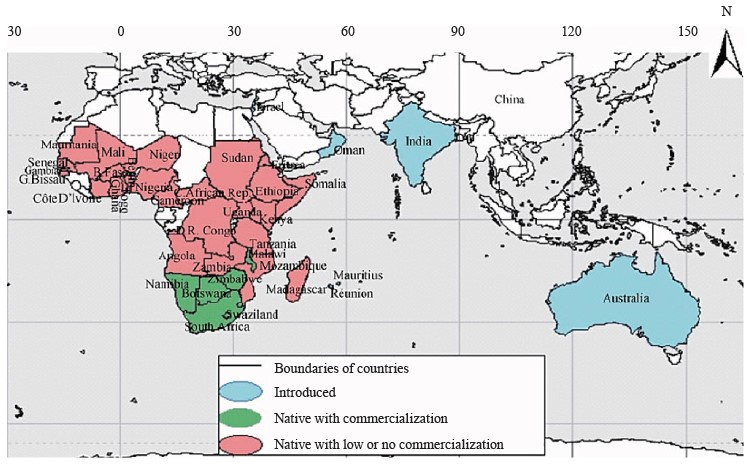
Citation analysis is a method of determining the relevance of an author or an article by counting the number of references to this author or article in other publications. National research assessments are conducted on a regular basis in numerous countries. They make it possible to compare citation indicators and peer ratings [44]. In this research, the Republic of South Africa appeared to have the largest number of citations, followed by the United States, Germany, the United Kingdom, Kenya, the Sudan, Zimbabwe, Burkina Faso, Nigeria, Namibia, Cameroon, Botswana, and France. The large number of citations obtained by Western countries indicated the global interest in S. birrea because of its medicinal and nutritional values [17, 34, 37, 38].
International collaboration and co-authorship links between countries. We analyzed the collaborative networks between various nations with a minimum of five documents published using VOSViewer (Fig. 5). The analysis revealed six clusters. We used the association method of normalization. Maximal iterations were 1000 steps, and the step size convergence was 0.001. Individual components (circled) were assembled to create a cluster and connected together by lines to represent partnerships or networks and their strength [25, 32, 33].
Figure 6 provide a visual representation of citations for countries with a minimum of five citations in 1986– 2022. Five clusters were extracted using association as a method of normalization. Maximal iterations were 1000 steps; the step size convergence was 0.001. Cluster 1 (dark red) involved ten countries with a total link strength of 1526. This cluster included the Republic of the Sudan, Germany, Italy, Belgium, Burkina Faso, the Netherlands, Mali, Israel, Tanzania, and Senegal, with the Total Link Strength of 135, 120, 62, 61, 51, 44, 40, 32, 29, and 18, respectively. The Sudan and Germany were the most cited countries in this cluster. The greater number of citations for the Sudan gave it preference in this group, despite the greater number of documents for Germany. Clusters 2 (green), 3 (blue), 4 (gold), and 5 (purple) comprised 9, 5, 5, and 1, respectively. India was the only representative of Cluster 5.
Institutions and universities involved in S. birrea research in 1986–2022. A total of 160 institutions contributed to S. birrea studies, with 37 having at least five publications. Table 3 also shows the number of publications and citations for the universities with a minimum of eight documents. The number of universities and institutes from the Republic of South Africa represented about 70.05%, while the Sudan, Germany, and Namibia represented about 29.5%. The University of Pretoria, South Africa, had 29 publications and 757 total citations, which makes it university number one in the world in S. birrea research production and impact. Quantitative measures, such as citation counts, are often used to assess the research impact [53]. We used this index to compare the number of citations for the three universities that appeared to have the same number of scientific papers but differed in the number of citations. The University of South Africa, the Tshwane University of Technology, and The Council for Scientific and Industrial Research delivered 10 scientific papers, each with the number of citations as 42, 191, and 383, respectively (Table 3).
Mapping knowledge structure by keyword co-occurrence. The co-occurrence analysis provides an overview of the structure of the subjects researched, as assessed by the number of occurrences. The data are visualized as nodes of different size [54]. In the analysis of keyword co-occurrence, 362 out of 5617 keywords met the threshold of at least five occurrences, producing five clusters, 5532 links, and a total link strength of 16 413 (Fig. 7). The different colors indicate different general research foci. “Sclerocarya birrea” was the most popular key word (n = 262) with 153 links and a total link strength of 5532. In the analysis of the co-occurrence of authors’ keywords, 24 out of 1134 keywords met the threshold with a minimum of five occurrences, producing six clusters, 45 links, and a total link strength of 80 (Fig. 8). The top occurrences were: Sclerocarya birrea (n = 66), marula (n = 29), and medicinal plants (n = 21). Figure 9 visualizes the co-occurrence of 4480 index keywords, i.e., those chosen by publishers and standardized using publicly accessible vocabularies. Unlike authors’ keywords, indexed keywords take into consideration synonyms, spelling variations, and plurals [55]. VOSViewer extracted four clusters, 19 173 links, and a total link strength of 48 712. When we compared the number of all keywords (5617) with the index keywords (4480), we found out that the authors used all the indexed keywords.
Source of publications and bibliometric coupling. Between 1986 and 2022, a total of 187 periodicals published research works on S. birrea, i.e., original papers and conference proceedings. Table 4 focuses on journals with a minimum of five publications. Only ten journals satisfied this criterion, with Ethnopharmacology (Elsevier) having published 25 papers on S. birrea. Most of the journals are hosted by Elsevier, Springer, and Wiley Publishers. However, the South African Journal of Science became a standalone source. The Journal of Ethnopharmacology (Elsevier) and Forests, Trees, and Livelihoods (Taylor & Francis) took the lead in terms of average citation per journal. According to the data indexed in Scopus, agricultural and biological sciences led in terms of research outputs on S. birrea. The top three journals fell in the scope of this field. Figure 10 visualizes the analysis of coupling of all journals: 10 out of 187 journals met the threshold of at least five bibliometric couplings, producing three clusters, 42 links, and a total link strength of 1284. When two works in a bibliography refer to the same third work, it is known as bibliographic coupling.
Bibliographic coupling is a sign that the two works are likely to be about the same thing. When two documents share one or more citations, they are said to be bibliographically connected [56]. The South African Journal of Botany had the highest total link strength (531) followed by the Journal of Ethnopharmacology (521). The Tropical Animal Health and Production had the lowest total link strength (25).
Authors’ contribution in S. birrea research in 1986–2022. A total of 1114 researchers were identified as S. birrea research authors. Only 21 of these co-authors satisfied the minimal requirement of five marula-related articles within the specified time frame. Table 5 depicts the most prolific S. birrea authors. With 11 total publications, Alfred Maroyi of the University of Fort Hare, South Africa, had the most prolific research output. Bertrand Matthäus from the Max Rubner Institute, Germany, had 11 publications. Finnie, van Staden, and Witkowski delivered 10 articles. The role of bibliometric analysis is to combine various data, such as citations and number of publications, and produce some indicators to evaluate the real knowledge impact of particular researchers [57, 58]. Therefore, Maroyi proved to have a greater number of publications than van Staden, but Maroyi had a greater impact on generating knowledge and research quality (Table 5). Table 6 sums up the top cited articles.
We determined the average number of publishing and active years of an author’s outputs using a co-authorship analysis. Figure 11 shows a VOSViewer-based co-authorship analysis. The co-authorship network of authors was limited by a minimum of three publications made in 1986–2022. We extracted 28 clusters using the method of co-authorship analysis based on author mapping with 67 items, 58 links, and a total link strength of 198. According to our research, Matthäus, Mariod, Eichner and Hussein belonged to the same cluster and worked closely as a research collaboration team. Their research scope was S. birrea kernel oil [4]. This team is presented by green nodes in Fig. 11. van Staden and other five authors fell in Cluster 2. These researchers shared the same interests in ethnobotany and bioactive properties of S. birrea [60, 68].
The co-citation analysis has become a leading tool of empirical insight into the structure of scientific communication. Unlike bibliographic coupling, which is retroactive, the co-citation analysis assesses document similarity in advance. Co-citation frequencies may alter in the future as a result of the development of an academic area [69]. Figure 12 shows clusters arranged by the VOSViewer software. The co-citation network of the cited authors had a total link strength of 37 949 for authors with a minimum of 40 citations, and only 44 authors met this threshold. We classified them into three clusters. van Wyk, Elof, Lall, and van Staden belonged to Cluster 1 (green) with a total link strength of 3651, 4078, 4830, and 7500, respectively. Cluster 2 (red) included Shackleton, who showed the highest total link strength of 3126. Shackleton is a full-time research professor at the Department for Environmental Science at Rhodes University, Grahamstown, South Africa. Matthäus proved to be the most prolific researcher in Cluster 3 (blue).
CONCLUSION
The leaves, bark, root, and fruit of Sclerocarya birrea (A. Rich.) Hochst., also known as marula, are used in nutrition and traditional medicine in many African countries. Farmers eat its fruit raw, make marula wine, add seed juice to porridge, make jam, soda drinks, etc. The seed is surrounded by a delicate white kernel that is high in protein and oil. The oil, in its turn, is high in oleic, palmitic, myristic, and stearic acids, while the kernel protein is high in amino acids, with glutamic acid and arginine dominating. Extracts from various botanical parts of marula are known for their excellent total phenolic compounds, radical-scavenging capabilities, and antioxidant activities. Numerous studies have proved anti-diabetic, anti-inflammatory, analgesic, anti-parasitic, antibacterial, and antihypertensive properties of S. birrea. In addition, the tree provides shade in agricultural fields and is utilized to store maize plant remnants for animal feed later in the spring. Its parts serve as cattle forage. To sum it up, the numerous utility options and therapeutic properties of this tree led to scientific and research efforts that spread all over the world. It has become the focus of many scientific papers, books, conference proceedings, doctoral dissertations and Master’s theses. Some of these works entered the Scopus database, from which the authors of this research retrieved 370 papers in English, French, Japanese, and Chinese.
This study represented the first bibliometric analysis of publications related to S. birrea. It covered worldwide publishing patterns, national and international partnerships, institutional engagement, the role of individual researchers and scientific journals, etc. The Republic of South Africa appeared to be the leading country in S. birrea research, followed by the United States, Germany, Britain, Kenya, the Republic of the Sudan, and Zimbabwe. In spite of the fact that the tree does not grow in Europe, the wide involvement of European countries is evidence of strong academic cooperations. Many postgraduate students from African countries completed their studies in Europe. Some researchers send their samples to European universities to be examined by advanced instruments.
The goal of any bibliometric analysis is to integrate diverse data, such as citations and the number of publications, as well as to develop certain indications that may be used to assess the true knowledge effect of various academics. In our study, Maroyi and van Staden appeared to have a lot of publications on the matter, but Maroyi proved to have a greater impact on creating knowledge and improving the overall quality of S. birrea research. Most publications were in agriculture and forestry (35.8%). However, many South-African researchers in the fields of pharmacy and medicine published their research materials in the Journal of Ethnopharmacology, which became the top journal on S. birrea with its 28 articles. Between 1986 and 2022, a total of 187 periodicals published marula-related articles. The prospects are such that S. birrea studies might one day become a bridge for research cooperation between Africa and the West. We expect that many scientific papers on the beneficial properties of marula will be published in the agricultural, environmental, and medical fields in the near future as researchers are urged to develop food and pharmaceutical products for commercialization.
Contribution
All authors have contributed equally to this project.
CONFLICTS OF INTEREST
The authors declared no conflict of interest regarding the publication of this article.
ACKNOWLEDGEMENTS
The authors are grateful to the Saudi Digital Library for their generous support in providing full access to their database.
FUNDING
The authors extend their appreciation to the Deputyship for Research & Innovation, Ministry of Education in Saudi Arabia, for funding this research work through the project number ISP23-82.REFERENCES
- Manhivi VE, Slabbert RM, Sivakumar D. Co-ingestion of natal plums (Carissa macrocarpa) and marula nuts (Sclerocarya birrea) in a snack bar and its effect on phenolic compounds and bioactivities. Molecules. 2022;27(1):310. https://doi.org/10.3390/molecules27010310
- Mariod AA, Abdelwahab SI. Sclerocarya birrea (Marula), an African tree of nutritional and medicinal uses: A review. Food Reviews International. 2012;28(4):375–388. https://doi.org/10.1080/87559129.2012.660716
- Samikannu R, Raj RA, Murugesan S, Venkatachary SK, Stonier AA. Assessing the dielectric performance of Sclerocarya birrea (Marula oil) and mineral oil for eco-friendly power transformer applications. Alexandria Engineering Journal. 2022;61(1):355–366. https://doi.org/10.1016/j.aej.2021.06.002
- Mariod A, Matthäus B, Eichner K, Hussein IH. Improving the oxidative stability of sunflower oil by blending with Sclerocarya birrea and Aspongopus viduatus oils. Journal of Food Lipids. 2005;12(2):150–158. https://doi.org/10.1111/j.1745-4522.2005.00013.x
- Glew RS, VanderJagt DJ, Huang Y-S, Chuang L-T, Bosse R, Glew RH. Nutritional analysis of the edible pit of Sclerocarya birrea in the Republic of Niger (daniya, Hausa). Journal of Food Composition and Analysis. 2004;17(1):99–111. https://doi.org/10.1016/S0889-1575(03)00101-7
- Vermaak I, Kamatou GPP, Komane-Mofokeng B, Viljoen AM, Beckett K. African seed oils of commercial importance – Cosmetic applications. South African Journal of Botany. 2011;77(4):920–933. https://doi.org/10.1016/j.sajb.2011.07.003
- Shackleton SE, Shackleton CM, Cunningham T, Lombard C, Sullivan CA, Netshiluvhi TR. Knowledge on Sclerocarya birrea subsp. caffra with emphasis on its importance as a non-timber forest product in South and southern Africa: A summary. Part 1: Taxonomy, ecology and role in rural livelihoods. Southern African Forestry Journal. 2002;194(1):27–41. https://doi.org/10.1080/20702620.2002.10434589
- Ngueguim FT, Esse EC, Dzeufiet PDD, Gounoue RK, Bilanda DC, Kamtchouing P, et al. Oxidised palm oil and sucrose induced hyperglycemia in normal rats: Effects of Sclerocarya birrea stem barks aqueous extract. BMC Complementary Medicine and Therapies. 2015;16:47. https://doi.org/10.1186/s12906-016-1009-0
- Komane B, Vermaak I, Summers B, Viljoen A. Safety and efficacy of Sclerocarya birrea (A. Rich.) Hochst (Marula) oil: A clinical perspective. Journal of Ethnopharmacology. 2015;176:327–335. https://doi.org/10.1016/j.jep.2015.10.037
- Zimba N, Wren S, Stucki A. Three major tree nut oils of southern central Africa: Their uses and future as commercial base oils. International Journal of Aromatherapy. 2005;15(4):177–182. https://doi.org/10.1016/j.ijat.2005.10.009
- Prinsloo G, Street RA. Marula [Sclerocarya birrea (A. Rich) Hochst]: A review of traditional uses, phytochemistry, and pharmacology. In: Juliani HR, Simon JE, Ho C-T, editors. African natural plant products Volume II: Discoveries and challenges in chemistry, health, and nutrition. Washington: American Chemical Society; 2013. pp. 19–32. https://doi.org/10.1021/bk-2013-1127.ch002
- Braca A, Politi M, Sanogo R, Sanou H, Morelli I, Pizza C, et al. Chemical composition and antioxidant activity of phenolic compounds from wild and cultivated Sclerocarya birrea (Anacardiaceae) leaves. Journal of Agricultural and Food Chemistry. 2003;51(23):6689–6695. https://doi.org/10.1021/jf030374m
- Mariod AA, Matthäus B, Hussein IH. Antioxidant properties of methanolic extracts from different parts of Sclerocarya birrea. International Journal of Food Science and Technology. 2008;43(5):921–926. https://doi.org/10.1111/j.1365-2621.2007.01543.x
- Musabayane CT, Gondwe M, Kamadyaapa DR, Moodley K, Ojewole JAO. The effects of Sclerocarya birrea [(a. rich.) hochst.][Anacardiaceae] stem-bark aqueous extract on blood glucose, kidney and cardiovascular function in rats. Endocrine Abstracts. 2006;12.
- Gathirwa JW, Rukunga GM, Njagi ENM, Omar SA, Mwitari PG, Guantai AN, et al. The in vitro anti-plasmodial and in vivo anti-malarial efficacy of combinations of some medicinal plants used traditionally for treatment of malaria by the Meru community in Kenya. Journal of Ethnopharmacology. 2008;115(2):223–231. https://doi.org/10.1016/j.jep.2007.09.021
- Belemtougri RG, Traore A, Ouedraogo Y, Sanou SD, Sawadogo L. Toxicological effects of Sclerocarya birrea (A. Rich) Hochst (Anacardiaceae) and Psidium guajava L.(Myrtaceae) leaf extracts on mice and their pharmacological effects on rat duodenum. International Journal of Pharmacology. 2006;2(5):557–562. https://doi.org/10.3923/ijp.2006.557.562
- Galvez J, Zarzuelo A, Crespo ME, Utrilla MP, Jimenez J, Spiessens C, et al. Antidiarrhoeic activity of Sclerocarya birrea bark extract and its active tannin constituent in rats. Phytotherapy Research. 1991;5(6):276–278. https://doi.org/10.1002/ptr.2650050611
- Garba SH, Ahmadu S, John IA. The effect of aqueous stem bark extract of Sclerocarya birrea (Hoechst) on alcohol carbon tetrachloride induced liver damage in rats. Pakistan Journal of Biological Sciences. 2006;9(12):2283–2287. https://doi.org/10.3923/pjbs.2006.2283.2287
- Glew RH, Glew RS, Chuang L-T, Huang Y-S, Millson M, Constans D, et al. Amino acid, mineral and fatty acid content of pumpkin seeds (Cucurbita spp) and Cyperus esculentus nuts in the Republic of Niger. Plant Foods for Human Nutrition. 2006;61:49–54. https://doi.org/10.1007/s11130-006-0010-z
- Ojewole JAO. Hypoglycemic effect of Sclerocarya birrea {(A. Rich.) Hochst.}[Anacardiaceae] stem-bark aqueous extract in rats. Phytomedicine. 2003;10(8):675–681. https://doi.org/10.1078/0944-7113-00295
- van Wyk JA, Malan FS, Randles JL. How long before resistance makes it impossible to control some field strains of Haemonchus contortus in South Africa with any of the modern anthelmintics? Veterinary Parasitology. 1997;70(1–3):111–122. https://doi.org/10.1016/S0304-4017(96)01147-8
- Concari A, Kok G, Martens P. Recycling behaviour: Mapping knowledge domain through bibliometrics and text mining. Journal of Environmental Management. 2022;303:114160. https://doi.org/10.1016/j.jenvman.2021.114160
- Faskhutdinova ER, Sukhikh AS, Le VM, Minina VI, Khelef MEA, Loseva AI. Effects of bioactive substances isolated from Siberian medicinal plants on the lifespan of Caenorhabditis elegans. Foods and Raw Materials. 2022;10(2):340–352. https://doi.org/10.21603/2308-4057-2022-2-544
- Alfonzo PM, Sakaraida T, Hasting-Tolsma M. Bibliometrics: Visualizing the impact of nursing research. Online Journal of Nursing Informatics. 2014;18(1).
- Kokol P, Blažun Vošner H, Završnik J. Application of bibliometrics in medicine: A historical bibliometrics analysis. Health Information and Libraries Journal. 2020;38(2):125–138. https://doi.org/10.1111/hir.12295
- Boudry C. Availability of ORCIDs in publications archived in PubMed, MEDLINE, and Web of Science Core Collection. Scientometrics. 2021;126:3355–3371. https://doi.org/10.1007/s11192-020-03825-7
- Kokol P, Vošner HB. Discrepancies among Scopus, Web of Science, and PubMed coverage of funding information in medical journal articles. Journal of the Medical Library Association. 2018;106(1):81–86. https://doi.org/10.5195/JMLA.2018.181
- Thelwall M. Dimensions: A competitor to Scopus and the Web of Science? Journal of Informetrics. 2018;12(2):430–435. https://doi.org/10.1016/j.joi.2018.03.006
- Burnham JF. Scopus database: A review. Biomedical Digital Libraries. 2006;3:1. https://doi.org/10.1186/1742-5581-3-1
- Martín-Martín A, Orduna-Malea E, Thelwall M, López-Cózar ED. Google Scholar, Web of Science, and Scopus: A systematic comparison of citations in 252 subject categories. Journal of Informetrics. 2018;12(4):1160–1177. https://doi.org/10.1016/j.joi.2018.09.002
- Zhu J, Liu W. A tale of two databases: The use of Web of Science and Scopus in academic papers. Scientometrics. 2020;123:321–335. http://dx.doi.org/10.1007/s11192-020-03387-8
- Orduña-Malea E, Costas R. Link-based approach to study scientific software usage: The case of VOSviewer. Scientometrics. 2021;126:8153–8186. https://doi.org/10.1007/s11192-021-04082-y
- van Eck NJ, Waltman L. Software survey: VOSviewer, a computer program for bibliometric mapping. Scientometrics. 2010;84:523–538. https://doi.org/10.1007/s11192-009-0146-3
- Eloff JN. Antibacterial activity of Marula (Sclerocarya birrea (A. rich.) Hochst. subsp. caffra (Sond.) Kokwaro) (Anacardiaceae) bark and leaves. Journal of Ethnopharmacology. 2001;76(3):305–308. https://doi.org/10.1016/S0378-8741(01)00260-4
- Gouwakinnou GN, Lykke AM, Assogbadjo AE, Sinsin B. Local knowledge, pattern and diversity of use of Sclerocarya birrea. Journal of Ethnobiology and Ethnomedicine. 2011;7:8. https://doi.org/10.1186/1746-4269-7-8
- Ndhlala AR, Kasiyamhuru A, Mupure C, Chitindingu K, Benhura MA, Muchuweti M. Phenolic composition of Flacourtia indica, Opuntia megacantha and Sclerocarya birrea. Food Chemistry. 2007;103(1):82–87. https://doi.org/10.1016/j.foodchem.2006.06.066
- Fouche G, Adenubi OT, Leboho T, McGaw LJ, Naidoo V, Wellington KW, et al. Acaricidal activity of the aqueous and hydroethanolic extracts of 15 South African plants against rhipicephalus turanicus and their toxicity on human liver and kidney cells. Onderstepoort Journal of Veterinary Research. 2019;86(1):a1951. https://doi.org/10.4102/ojvr.v86i1.1665
- Fouche G, Ramafuthula M, Maselela V, Mokoena M, Senabe J, Leboho T, et al. Acaricidal activity of the organic extracts of thirteen South African plants against Rhipicephalus (Boophilus) decoloratus (Acari: Ixodidae). Veterinary Parasitology. 2016;224:39–43. https://doi.org/10.1016/j.vetpar.2016.05.011
- Koné WM, Vargas M, Keiser J. Anthelmintic activity of medicinal plants used in Côte d'Ivoire for treating parasitic diseases. Parasitology Research. 2012;110:2351–2362. https://doi.org/10.1007/s00436-011-2771-z
- McGaw LJ, van der Merwe D, Eloff JN. In vitro anthelmintic, antibacterial and cytotoxic effects of extracts from plants used in South African ethnoveterinary medicine. The Veterinary Journal. 2007;173(2):366–372. https://doi.org/10.1016/j.tvjl.2005.09.004
- Ndlela SZ, Mkwanazi MV, Chimonyo M. In vitro efficacy of plant extracts against gastrointestinal nematodes in goats. Tropical Animal Health and Production. 2021;53:295. https://doi.org/10.1007/s11250-021-02732-0
- Bhatt PR, Pandya KB, Patel UP, Patel HB, Modi CM. Survey on ethnoveterinary practices around Junagadh, Gujarat, India. Indian Journal of Pharmaceutical Sciences. 2019;81(1):161–167. https://doi.org/10.4172/pharmaceutical-sciences.1000493
- Mokgolodi NC, Ding Y, Setshogo MP, Ma C, Liu Y. The importance of an indigenous tree to southern African communities with specific relevance to its domestication and commercialization: A case of the marula tree. Forestry Studies in China. 2011;13:36–44. https://doi.org/10.1007/s11632-011-0110-1
- Aksnes DW, Langfeldt L, Wouters P. Citations, citation indicators, and research quality: An overview of basic concepts and theories. SAGE Open. 2019;9. https://doi.org/10.1177/2158244019829575
- Mariod A, Matthäus B, Eichner K. Fatty acid, tocopherol and sterol composition as well as oxidative stability of three unusual sudanese oils. Journal of Food Lipids. 2005;11(3):179–189. https://doi.org/10.1111/j.1745-4522.2004.01131.x
- Mariod A, Matthäus B, Eichner K, Hussein IH. Frying quality and oxidative stability of two unconventional oils. Journal of the American Oil Chemists' Society. 2006;83(6):529–538. https://doi.org/10.1007/s11746-006-1236-5
- Mariod A, Matthäus B, Eichner K, Hussein IH. Long-term storage of three unconventional oils. Grasas y Aceites. 2008;59(1):16–22.
- Mariod A, Matthäus B, Eichner K, Hussein IH. Phenolic compounds of three unconventional sudanese oils. Acta Scientiarum Polonorum, Technologia Alimentaria. 2015;14(1):63–69. https://doi.org/10.17306/J.AFS.2015.1.7
- Mariod A, Matthäus B, Hussein IH. Effect of stripping methods on the oxidative stability of three unconventional oils. Journal of the American Oil Chemists' Society. 2010;88(5):603–609. https://doi.org/10.1007/s11746-010-1703-x
- Mariod AA, Matthäus B, Eichner K, Hussein IH. Antioxidant activity of extracts from Sclerocarya birrea kernel oil cake. Grasas y Aceites. 2006;57(4):361–366.
- Mariod AA, Matthäus B, Idris YMA, Abdelwahab SI. Fatty acids, tocopherols, phenolics and the antimicrobial effect of Sclerocarya birrea kernels with different harvesting dates. Journal of the American Oil Chemists' Society. 2009;87(4):377–384. https://doi.org/10.1007/s11746-009-1510-4
- Taha E, Mariod A, Abouelhawa S, El-Geddawy M, Sorour M, Matthäus B. Antioxidant activity of extracts from six different Sudanese plant materials. European Journal of Lipid Science and Technology. 2010;112(11):1263–1269. https://doi.org/10.1002/ejlt.201000326
- Ajiferuke I, Wolfram D. Citer analysis as a measure of research impact: Library and information science as a case study. Scientometrics. 2010;83:623–638. https://doi.org/10.1007/s11192-009-0127-6
- Tijssen RJW, van Raan AFJ. Mapping changes in science and technology: Bibliometric co-occurrence analysis of the R&D literature. Evaluation Review. 1994;18(1):98–115. https://doi.org/10.1177/0193841X9401800110
- Ikeda D, Taniguchi Y, Koga K. The Normalized Impact Index for Keywords in Scholarly Papers to Detect Subtle Research Topics. Proceedings of the 8th International Workshop on Mining Scientific Publications. Wuhan: Association for Computational Linguistics; 2020. p. 42–47.
- Thelwall M, Wilkinson D. Finding similar academic Web sites with links, bibliometric couplings and colinks. Information Processing and Management. 2004;40(3):515–526. https://doi.org/10.1016/S0306-4573(03)00042-6
- Karakus M, Ersozlu A, Clark AC. Augmented reality research in education: A bibliometric study. Eurasia Journal of Mathematics, Science and Technology Education. 2019;15(10):em1755. https://doi.org/10.29333/ejmste/103904
- Yu Y, Li Y, Zhang Z, Gu Z, Zhong H, Zha Q, et al. A bibliometric analysis using VOSviewer of publications on COVID-19. Annals of Translational Medicine. 2020;8(13):816. https://doi.org/10.21037/atm-20-4235
- Rasoanaivo P, Wright CW, Willcox ML, Gilbert B. Whole plant extracts versus single compounds for the treatment of malaria: Synergy and positive interactions. Malaria Journal. 2011;10:S4. https://doi.org/10.1186/1475-2875-10-S1-S4
- Moyo M, Ndhlala AR, Finnie JF, van Staden J. Phenolic composition, antioxidant and acetylcholinesterase inhibitory activities of Sclerocarya birrea and Harpephyllum caffrum (Anacardiaceae) extracts. Food Chemistry. 2010;123(1):69–76. https://doi.org/10.1016/j.foodchem.2010.03.130
- van de Venter M, Roux S, Bungu LC, Louw J, Crouch NR, Grace OM, et al. Antidiabetic screening and scoring of 11 plants traditionally used in South Africa. Journal of Ethnopharmacology. 2008;119(1):81–86. https://doi.org/10.1016/j.jep.2008.05.031
- Akinnifesi FK, Kwesiga F, Mhango J, Chilanga T, Mkonda A, Kadu CAC, et al. Towards the development of Miombo fruit trees as commercial tree crops in Southern Africa. Forests, Trees and Livelihoods. 2006;16(1):103–121. https://doi.org/10.1080/14728028.2006.9752548
- Cho MA, Debba P, Mathieu R, Naidoo L, van Aardt J, Asner GP. Improving discrimination of Savanna Tree species through a multiple-endmember spectral angle mapper approach: Canopy-level analysis. IEEE Transactions on Geoscience and Remote Sensing. 2010;48(11):4133–4142. https://doi.org/10.1109/TGRS.2010.2058579
- Musa MS, Abdelrasool FE, Elsheikh EA, Ahmed LAMN, Mahmoud ALE, Yagi SM. Ethnobotanical study of medicinal plants in the Blue Nile State, South-eastern Sudan. Journal of Medicinal Plants Research. 2011;5(17):4287–4297.
- Hamza OJM, van den Bout-van den Beukel CJP, Matee MIN, Moshi MJ, Mikx FHM, Selemani HO, et al. Antifungal activity of some Tanzanian plants used traditionally for the treatment of fungal infections. Journal of Ethnopharmacology. 2006;108(1):124–132. https://doi.org/10.1016/j.jep.2006.04.026
- Lamien-Meda A, Lamien CE, Compaoré MMY, Meda RNT, Kiendrebeogo M, Zeba B, et al. Polyphenol content and antioxidant activity of fourteen wild edible fruits from Burkina Faso. Molecules. 2008;13(3):581–594. https://doi.org/10.3390/molecules13030581
- Rwomushana I, Ekesi S, Gordon I, Ogol CKPO. Host plants and host plant preference studies for Bactrocera invadens (Diptera: Tephritidae) in Kenya, a new invasive fruit fly species in Africa. Annals of the Entomological Society of America. 2008;101(2):331–340. https://doi.org/10.1603/0013-8746(2008)101[331:HPAHPP]2.0.CO;2
- Moyo M, Finnie JF, van Staden J. In vitro morphogenesis of organogenic nodules derived from Sclerocarya birrea subsp. caffra leaf explants. Plant Cell, Tissue and Organ Culture. 2009;98:273–280. https://doi.org/10.1007/s11240-009-9559-1
- Annarelli A, Battistella C, Nonino F, Parida V, Pessot E. Literature review on digitalization capabilities: Co-citation analysis of antecedents, conceptualization and consequences. Technological Forecasting and Social Change. 2021;166:120635. https://doi.org/10.1016/j.techfore.2021.120635


